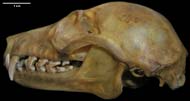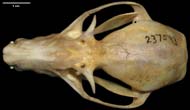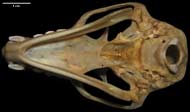This page serves supplemental imagery for a paper entitled The internal nasal skeleton of the bat Pteropus lylei K. Andersen, 1908 (Chiroptera: Pteropodidae, by N.P. Giannini, T.E. Macrini, J.R. Wible, T.B. Rowe and N.B. Simmons (2012, Annals of Carnegie Museum, 81, 1-17). The abstract is as follows:
The cranial osteology of the megachiropteran Pteropus Brisson, 1762, was the subject of recent study that covered all of the skull bones in significant detail, except for the anatomy of the nasal capsule. Here, we describe and illustrate the internal nasal skeleton of Pteropus lylei K. Andersen, 1908, using histological sections of a fetus and high resolution X-ray computed tomographic (HRXCT) imagery of an adult specimen. The internal nasal skeleton of Pteropus lacks a rostral nasoturbinal and includes a caudal nasoturbinal that corresponds to the ossified crista semicircularis of the fetus; three endoturbinals; one ectoturbinal; the maxilloturbinal; and a low basal crest that may represent a rudimentary element. We describe in detail the structure and connections of these elements in Pteropus. The maxilloturbinal is the largest element. In cross section, the caudal nasoturbinal is unilaminar, the maxilloturbinal is double bilaminar (i.e., each of the basal twin laminae splits further into two secondary laminae), and the other elements range from incipient to asymmetrically double bilaminar (i.e., one branch simple, the other split). All turbinals of the ethmoidal labyrinth contribute to the cribriform plate, creating a specific pattern of cribriform foramina. The elements found in Pteropus are compared with those of other well-known mammals with relatively few turbinal elements, including other bats, primates, canids, and marsupials. We show that, despite terminological discrepancies across studies, homologies are straightforward to establish among these taxa and so comparative or phylogenetic studies may benefit from inclusion of turbinal characters.















